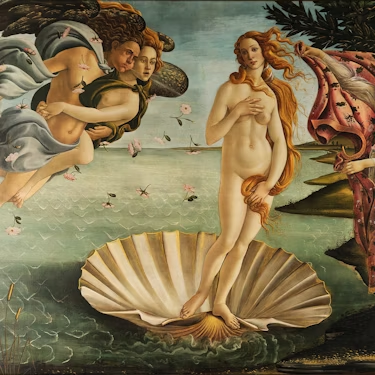More about: 12 Best Paintings at the Uffizi Gallery
The Uffizi Gallery is a must-see. It is the most visited museum in Florence, as well as in Italy in general, and houses some of the most important works of art in the world such as Botticelli's 'Primavera' and 'The Birth of Venus', Raphael's 'Madonna of the Goldfinch', Michelangelo's 'Tondo Doni', Filippo Lippi's 'Madonna and Child with two Angels', Giotto's 'La Maestà di Ognissanti', Caravaggio's 'Bacchus' and Piero della Francesca's 'Portrait of the Dukes of Urbino', among others. Do you want to know all the works you can see during your visit? Read on.
And if you want additional information about the gallery, see the post tickets to the Uffizi Gallery In addition, you can learn about other proposals for your trip to the capital of Tuscany in the article what to see and do in Florence.
1. Botticelli's 'Primavera' (Spring)

'La Primavera' is one of Sandro Botticelli's masterpieces. It was painted between 1477 and 1482 at the height of the Italian Renaissance and is an allegory of spring. This work, which measures 2.03 x 3.14 meters, was commissioned by Lorenzo di Pierfrancesco de Medici.
There are different interpretations of this key painting in Botticeli's career, which stands out for the elegance of its characters and the impeccable use of color. But most share that the central figure is that of Venus, who represents the harmony and balance between nature and spiritual values (on the left of the painting) and civilization and material values (on the right). A fascinating work.
- This work can be found in... rooms 10/14.
2. The Birth of Venus' by Botticelli
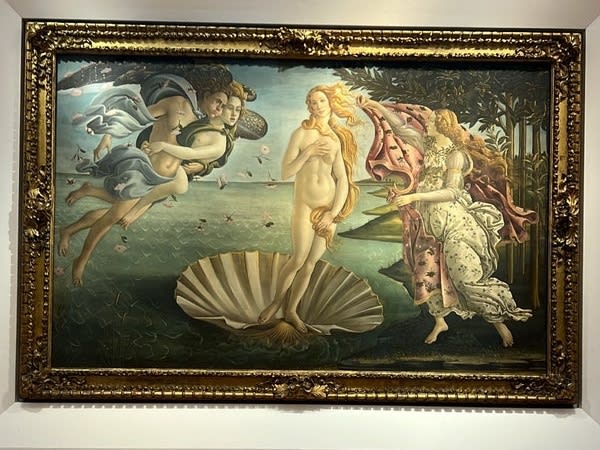
Painted between 1482 and 1485, 'The Birth of Venus' is another of Botticelli's great works. It is notable for its large dimensions, 278.5 cm. by 172.5 cm. and is one of the earliest examples of painting on canvas from the Tuscan region. It is characterized by its technique, as well as by the quality of the materials used, among which alabaster powder stands out.
This work has several meanings and shows in the center of the painting Venus naked in a shell on the seashore as an allegory of the birth of love, as well as of spiritual beauty. To her left the winds blow flowers and to her right a servant is going to cover her with a cloth.
- This work can be found in... rooms 10/14.
3. Tondo Doni' by Michelangelo
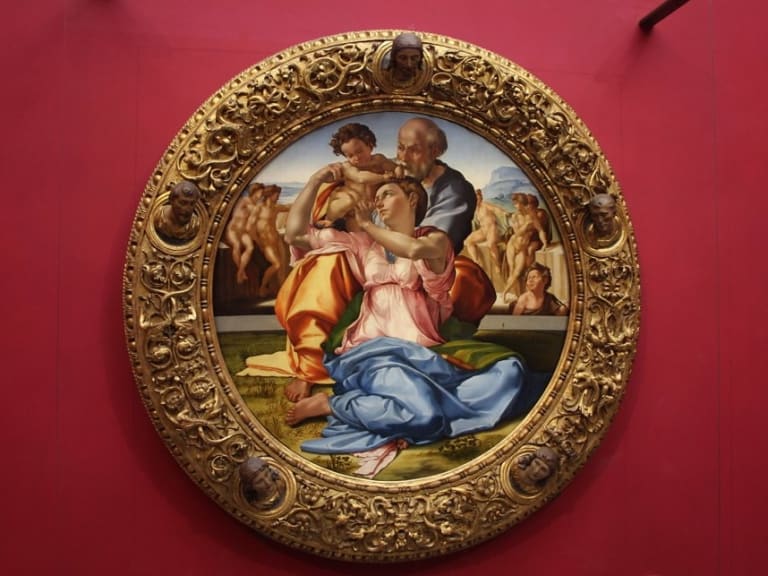
Created by Michelangelo after his first stay in Rome, the Tondo Doni or Holy Family dates from the same period as the David, between 1506 and 1508, and is considered one of the great works of Italian art of the sixteenth century, as well as one of the few paintings by the artist next to the frescoes of the Sistine Chapel. It was commissioned by the banker Agnolo Doni and measures 120 cm by 120 cm.
In an extraordinary wooden frame carved by Michelangelo himself, the work shows Mary, Joseph and the Child, and in the background a series of nude figures. It is a painting that marks a turning point in history, as it will lay the foundations of the mannerist style that will later be widely used by great artists and which advocates unnatural postures that provide a characteristic movement to the work. Precisely, this strange position can be seen in the figure of Mary.
- This work is located in... room 35.
4. Portrait of the Dukes of Urbino' by Piero della Francesca

The diptych 'The Portrait of the Dukes of Urbino' was executed by Piero della Francesca between 1465 and 1472 and is one of the major works of the Italian Renaissance.
It portrays in profile the dukes and spouses Federigo da Montefeltro and Battista Sforza, as was customary in classical times, although the choice of this shot was more out of obligation as Federigo da Montefeltro lost his right eye in a tournament. In the background of the paintings a large and deep landscape extends and reflects the power of the Court. One of the curiosities of this work is that it is also painted on the back.
- This work is located in... room 8.
5. Madonna of the Goldfinch by Raphael

'The Madonna of the Goldfinch' is one of Raphael's key works in which you can see the features that characterize his painting: the sweet faces of the figures, the magnificent use of color, the intimacy of the characters and a naturalistic representation of the landscape. In addition, the painter was greatly influenced by Leonardo da Vinci, from whom he adopted some of the characteristics of his painting such as the soft lights, the dialogue between the protagonists or the pyramidal placement of the figures.
This work, measuring 107 cm. by 77 cm., badly damaged since the 16th century, was restored on several occasions, but it was not until the last restoration in 2008 when it reached its full splendor.
- This work is located in... room 66.
6. The Madonna and Child with two Angels by Filippo Lippi
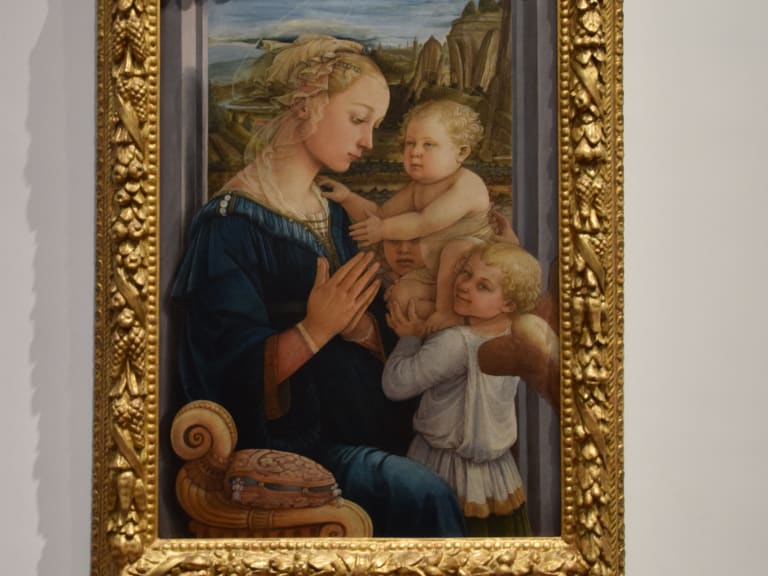
Executed around 1465 by Filippo Lippi, 'Madonna and Child with two Angels' is one of the most popular works of the Italian Renaissance and hides a curious history. Lippi was a Carmelite monk who fell in love with the nun Lucrezia Buti. They had a secret affair until they renounced religious life and had children, among them Filippino, a famous painter friend of Botticelli.
In 'Madonna and Child with two Angels', 100 cm. by 71 cm., the Virgin Mary is depicted with an elegant hairstyle decorated with a veil and pearls. She stands in profile praying in front of the child who is held by two angels. And behind them is a landscape inspired by Flemish style paintings. The particularity of this work is that many interpret that the face of the Virgin is the portrait of Lucrezia.
- This work is located in... room 8.
7. The Venus of Urbino' by Titian

'The Venus of Urbino' is a work by Titian, dating from 1538 and was commissioned by the Duke of Urbino Guidobaldo II della Rovere as a gift to his wife. Identified by many as an allegory of marriage, it stands out, above all, for its sensuality, although it has other significant features such as eroticism, motherhood or fidelity.
In this painting, measuring 1.19 m. by 1.65 m., Venus, the goddess of love, is represented in a sensual and erotic way, questioning the viewer. Next to her feet a dog, as a sign of the fidelity of marriage. And in the background, a maid looks at a girl looking in a drawer as a symbol of motherhood. It stands out for its excellent use of color and contrasts.
- This work can be found in... room 83.
8. Bacchus' by Caravaggio

Caravaggio was a turning point in the history of art. His painting was characterized by the use of warm colors, as well as by its realism and the depiction of humble characters.
Painted at the end of the 16th century, 'Bacchus', an oil on panel measuring 98 cm. by 84 cm., was a gift from Cardinal del Monte to the Grand Duke of Tuscany Ferdinando I. Precisely, in this painting, Bacchus is depicted as a humble, village youth reflecting humanity. He holds in his left hand a glass of wine that stands out for its transparency and there are other common objects such as a basket of fruit.
- This work is located in... room 90.
9. La Maestà di Ognissanti' by Giotto

Giotto revolutionized the history of painting and the way of representing men being one of the main artists of the Renaissance. 'La Maestà di Ognissanti ' is a large altarpiece, measuring 204 cm by 325 cm, which he made for the Ognissanti Church in Florence around 1310 approximately. Mary appears seated on a throne holding the child and the angels are in the foreground. The space is characterized by being very well defined and the folds of the clothes define the figures in the scene.
- This work is located in... room 2.
10. Altarpiece of Santa Lucia de Magnoli' by Domenico Veneziano
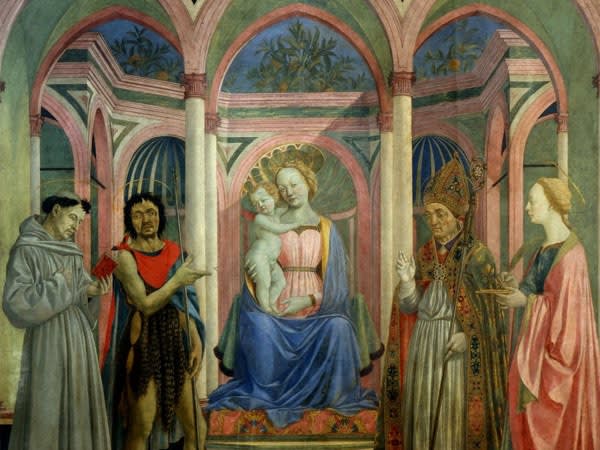
The work by Domenico Veneziano was made between 1445 and 1447 and depicts the Madonna and Child in the center. Next to her are St. Francis and St. John the Baptist on the left and St. Zenobius on the right. The altarpiece is characterized for being probably the oldest without gilded background and rectangular in shape, as well as for the luminous colors. Also noteworthy is the use of bright light as a fundamental element that enters through the upper right edge.
- This work is located in... room 7.
11. 'Judith beheading Holofernes' by Artemisia Gentileschi

The first female member of the Accademia di Arti del Disegno in Florence, Artemisia Gentileschi was a renowned and progressive Italian painter of the 17th century. Her paintings are characterized by the representation of strong women. Specifically, in 'Judith beheading Holofernes', the biblical heroine is depicted as she beheads her enemy the Assyrian leader Holofernes.
- This work is located in... room 90.
12. The Adoration of the Magi' by Gentile da Fabriano

Also known under the title Pala Strozzi, this large altarpiece with carved wooden frame dates from 1423 and is by Gentile da Fabriano. Commissioned by Palla Strozzi, it is one of the international Gothic style paintings, characterized by sophisticated forms, refined garments and courtly poses. This work shows the procession of the Magi and behind them is the portrait of Palla Strozzi.
- This work is located in... room 7.
Recommendations to see the best works of the Uffizi Gallery without crowds

On your visit to the Uffizi Gallery keep in mind the following recommendations to make your visit as successful as possible:
- Buy your ticket in advance: The Uffizi Gallery is the most visited museum in Florence. Every day it receives a large number of visitors and it is important to book your ticket in advance to avoid waiting in long lines and wasting unnecessary time at the ticket office. In addition, you can buy a ticket with priority access. The cheapest tickets for the Uffizi Gallery are priced from €30 on Hellotickets.
- Check the map: Before starting your visit, it is recommended that you check the map to see where the works you are most interested in are located and start the tour in that area.
- Go early in the morning: Due to the large number of visitors who come every day to the Uffizi Gallery it is preferable to go early in the morning to see the art gallery as quietly and comfortably as possible.
And after your visit to the Uffizi Gallery, do not hesitate to go see the Accademia Gallery. In addition, I suggest you visit the post the best museums in Florence and create the best program for your trip.

